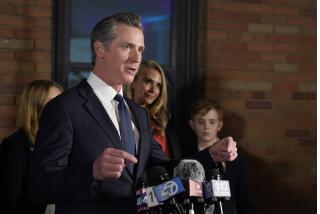Freewheeling Drivers Hit an OPEC Roadblock
- Share via
1908-1972. The American automobile rules.
1973. Pull over, buddy. The free ride is over.
For Americans, used to roaring down freeways, parkways and interstates in their eight-cylinder, leaded-gas, high-octane, 350-horsepower engines, the gas lines of the 1970s were the greatest alterer of the national ego since the Great Depression.
In 1973, the United States, king of the road for decades, was brought to a screeching halt by a tiny, far-off group of a dozen upstart nations, known as the Organization of Petroleum Exporting Countries (OPEC), that controlled three-fourths of all oil reserves.
Fed up with U.S. and European bullying on petroleum prices, OPEC was founded in 1960 by four Arab countries and Venezuela, to fight price cuts. In the 1970s, as world demand for oil and gas outstripped supplies, some Arab countries refused to ship supplies to countries that supported Israel, or cut their supplies sharply. The price of gasoline jacked up violently, quadrupling in a year, and sent shock ripples across the asphalt-laced nation.
Gov. Ronald Reagan, who less than a decade later would convince a grateful people that the good times were back and it was OK to overindulge again, invoked his disaster declaration powers in February 1974 to order gas rationing.
Here and across the nation, motorists were forced to line up on odd or even weekdays at gas stations, depending on the last digits of their license plates. With gas stations shut on Sundays, a weekend in Vegas became a scheduling nightmare.
Fistfights and attempted vehicular homicides were reported as frantic motorists tried to gas up before a long Washington’s birthday weekend in 1974. At one point that Friday, all police units in Los Angeles’ Southwest Division were assigned to traffic duty.
Motorists waited hours just to top off a tank. President Richard Nixon ordered the country, starting with federal officials, to cut energy consumption. Thermostats were lowered in the winter, raised in summer, and the sense of perpetual dusk and gloom deepened when Congress extended daylight savings time.
*
Forget power Caddys, Pontiac GTOs and roomy Oldsmobiles. Japanese subcompacts, once laughed at as toy cars, suddenly gained glamour with their impressive statistics. These numbers weren’t measured in the seconds it took to go from 0 to 60 mph, but in a newly important abbreviation: mpg. Boasting fuel economy of up to 45 miles per gallon, they zipped off showroom floors as consumers snapped them up.
Churning out hastily designed knockoffs, bombs like the Maverick and the exploding punch line known as the Pinto sent U.S. car companies into a tailspin.
During the late 1970s, the Iranian Revolution caused another shortage that helped OPEC raise prices again. A growing awareness settled in that there was in fact a finite amount of fossil fuels on Earth, and that the hourglass was beginning to run out. The fledgling environmental movement found its place in the sun.
President Jimmy Carter fueled the trend, pouring millions of dollars in government subsidies into solar power projects. On the other hand, nuclear power stations mushroomed across the nation in the ‘70s. Speed limits were cut to 55 mph nationwide, saving thousands of lives annually as well as cutting energy demands.
Although the whole nation at first felt uncomfortably off course, a sober logic settled in. Americans from top to bottom appeared to have learned the dangers of expecting a free ride forever.
Fast forward. 1999. Gasohol, electric vehicles, even rice-fueled vehicles are buzzing on the periphery but haven’t made it into mainstream car production. Carpool lanes are dismissed by many as a useless nuisance. Speed limits have been restored to a hearty 65 mph in most states, even 70 on some roads.
The best-selling vehicle in America isn’t even a car. It’s the hulking, gas-guzzling sport utility vehicle.
Has anyone noticed that gas prices are going up?
More to Read
Sign up for Essential California
The most important California stories and recommendations in your inbox every morning.
You may occasionally receive promotional content from the Los Angeles Times.













